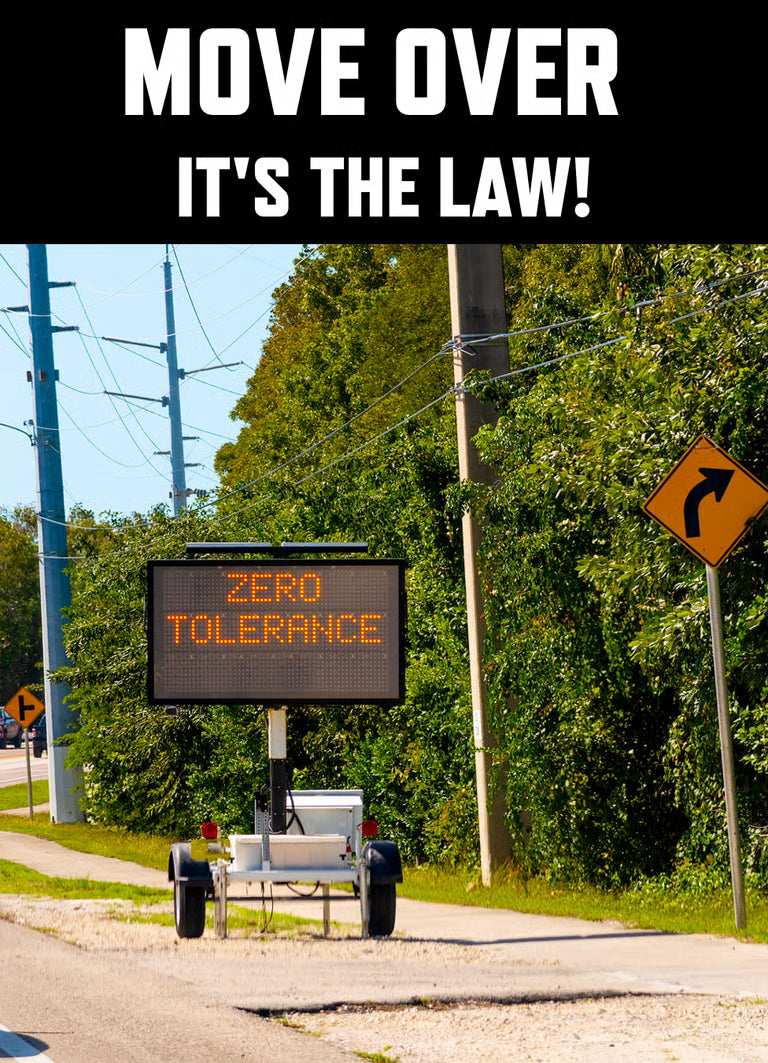
Move Over Laws: Protecting Those Who Protect Us
Share
Every day, police officers, tow truck drivers, and other emergency responders put their lives at risk working on busy roadways. Despite flashing lights, reflective gear, and years of training, these professionals face constant danger from distracted or reckless drivers who fail to give them the space they need to work safely. Move Over laws are designed to protect these individuals, but public awareness and compliance are still major hurdles.
A Personal Encounter with the Move Over Law
As a former law enforcement officer, I’ve had my fair share of close calls, but one particular incident on a four-lane freeway still stands out. It was 4 a.m., and traffic was almost non-existent. After conducting a traffic stop, I completed my checks on the driver and opened my patrol vehicle door to exit. I scanned the road—no cars in sight—and stepped out.
Suddenly, a powerful gust nearly spun me around. Inches from my head, a large pickup truck roared past in the lane closest to the shoulder. The road was otherwise empty, making it clear the driver had no reason to be in that lane. After finishing my initial stop, I pursued the truck and conducted another traffic stop.
The driver and passengers were all intoxicated, and the driver was arrested for DUI. What shocked me most, however, was when I asked why he didn’t follow the Move Over law. His response: “I never heard of that, you’re just making it up.”
This encounter has stuck with me, and it highlights a critical problem—too many drivers are unaware of these lifesaving laws.
What Are Move Over Laws?
Move Over laws exist in all 50 states and require drivers to change lanes or slow down significantly when approaching emergency vehicles, tow trucks, or roadside workers with flashing lights. These laws are essential for creating a buffer zone that protects roadside workers from oncoming traffic.
However, a National Highway Traffic Safety Administration (NHTSA) survey found that 71% of Americans are unaware of their state’s Move Over laws. This lack of awareness contributes to hundreds of preventable injuries and fatalities every year.
Speeding: A Critical Factor
Even among drivers who are aware of Move Over laws, speeding often prevents them from reacting in time. When drivers are traveling at high speeds, their ability to notice flashing lights, process the situation, and move over is significantly reduced.
Speeding is one of the most crucial factors in highway fatalities, contributing to nearly 29% of all traffic deaths in 2021, according to the NHTSA. Combine this with distracted driving—whether from texting, eating, or other activities—and the risks increase exponentially.
Even a fraction of a second can mean the difference between life and death for emergency responders and roadside workers. That’s why it’s so important for drivers to not only move over but also reduce their speed when approaching work zones or stopped vehicles with flashing lights.
The Ripple Effect of Non-Compliance
Failure to move over or slow down doesn’t just endanger the emergency worker—it puts everyone on the road at risk. Secondary crashes often occur when drivers brake suddenly or swerve to avoid a roadside incident. These chain reactions can involve multiple vehicles, leading to additional injuries or fatalities.
How You Can Help
- Understand the Law: Know your state’s Move Over laws and who they apply to—police officers, firefighters, tow truck drivers, construction workers, and more.
- Slow Down: Even if you can’t safely change lanes, reducing your speed can significantly lower the risk of a collision.
- Stay Alert: Keep your eyes on the road and watch for flashing lights, especially at night or in low-visibility conditions.
- Educate Others: Share information about Move Over laws with friends, family, and colleagues to raise awareness and encourage safer driving habits.
A Call to Action
Move-over laws are more than just a legal requirement—they’re a way to protect those who protect us. But laws alone aren’t enough. As drivers, we need to take responsibility for our actions, slow down, and give emergency workers the space to do their jobs safely.
Next time you see flashing lights on the roadside, remember to move over, slow down, and stay alert. It could save a life.
Sources:
- National Highway Traffic Safety Administration (NHTSA) - Move Over Laws: nhtsa.gov
- NHTSA - Speeding and Speed Management: nhtsa.gov
- Towing and Recovery Association of America (TRAA) - Move Over Laws: traaonline.com
- NHTSA - 2021 Traffic Fatalities Estimate: nhtsa.gov